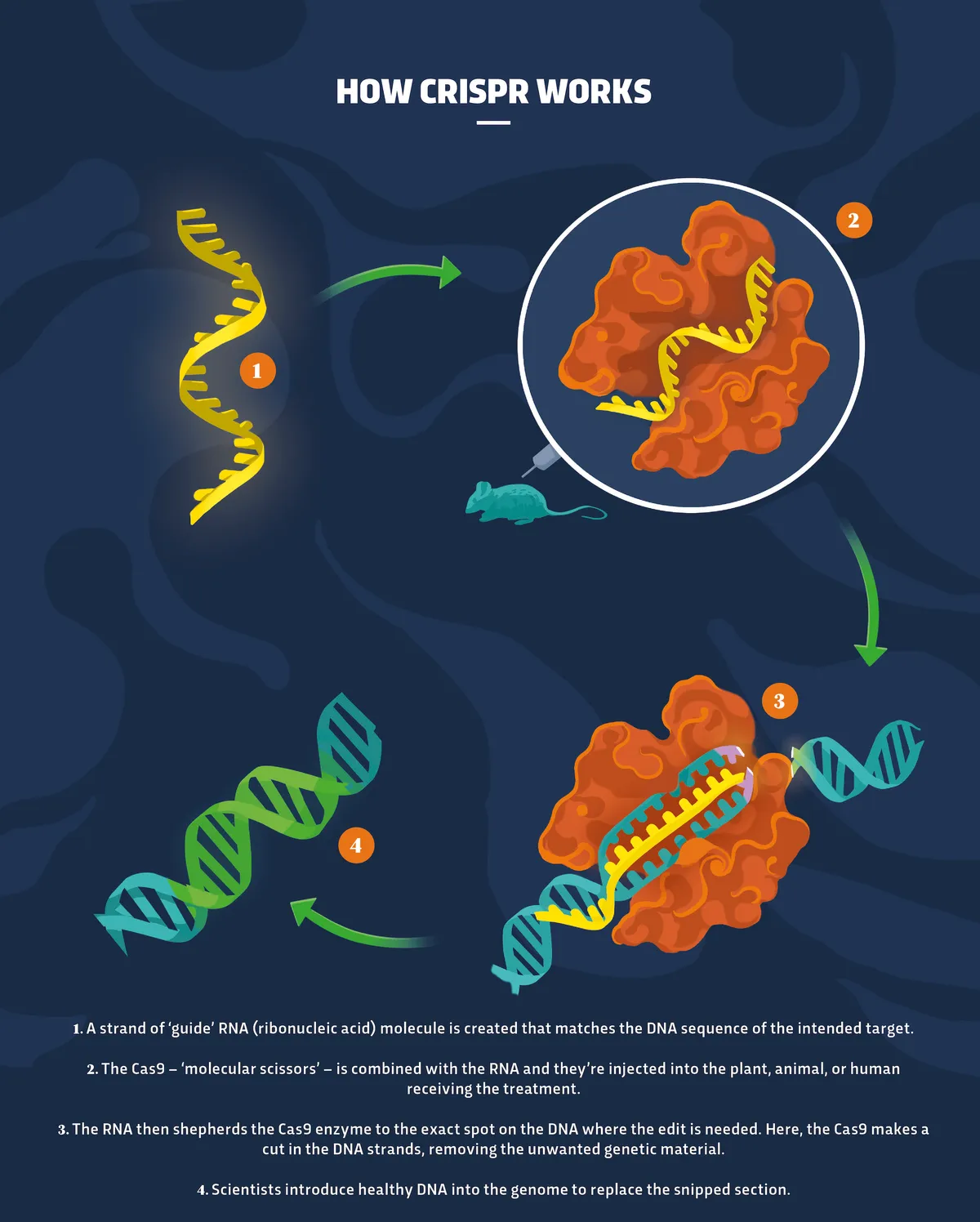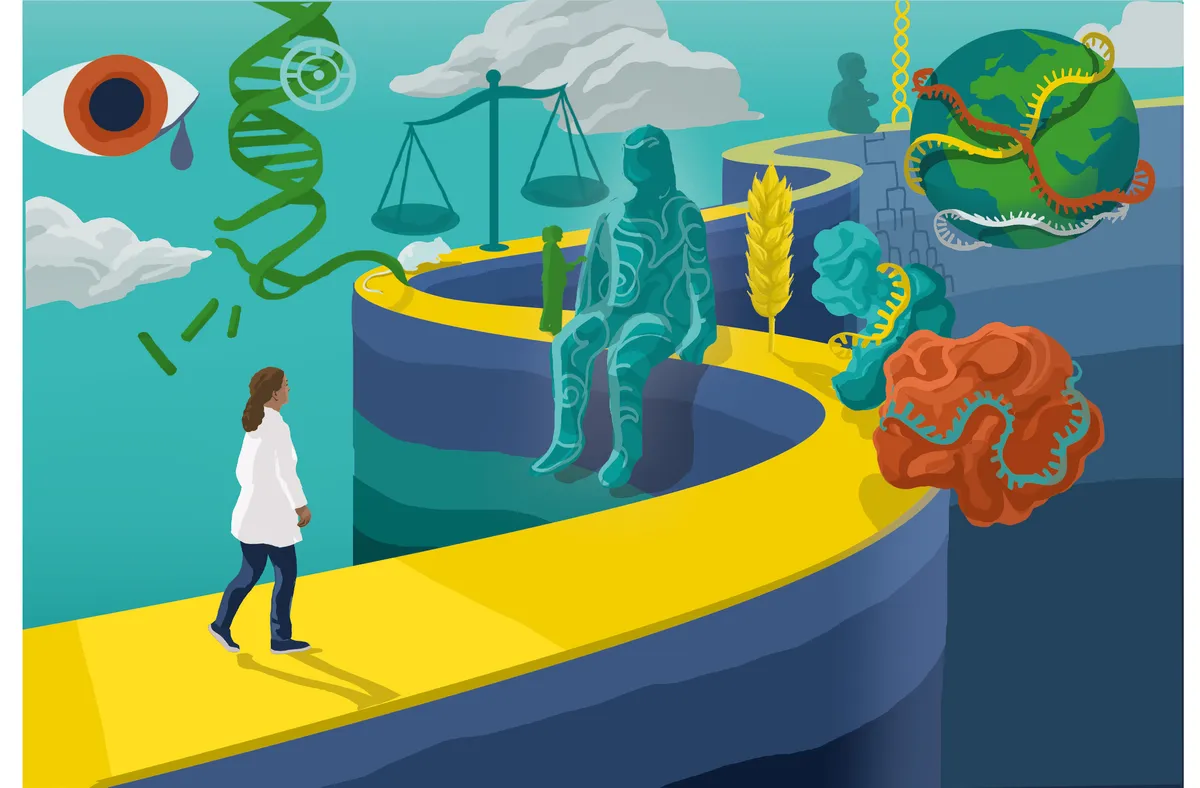Genuine eureka moments are rare in science, but one occurred a decade ago when research into a curious function of bacteria immunology exploded into a Nobel Prize-winning discovery. The 2012 paper by Jennifer Doudna and Emmanuelle Charpentier is already recognised as a landmark of science.
Researchers had been piecing together information about CRISPR (clustered regularly interspaced short palindromic repeats) since the 1980s. In nature, it’s a molecular defence mechanism that bacteria use to detect and destroy the DNA of an invading virus, like a set of microscopic scissors.
When a bacterium is infected, the ‘scissors’ cut and paste a segment of the virus DNA and insert it into its own genome. This trains the system to recognise that DNA and destroy it.
The major breakthrough came when scientists isolated the specific enzymes and RNA (ribonucleic acid) that made up the genetic scissors. Reproducing it in a lab turned CRISPR into a tool that accelerated the speed of biological research. It was a simple way to edit the genomes of any living thing.
How does CRISPR work?

1. A strand of ‘guide’ RNA (ribonucleic acid) molecule is created that matches the DNA sequence of the intended target.
2. The Cas9 – ‘molecular scissors’ – is combined with the RNA and they’re injected into the plant, animal, or human receiving the treatment.
3. The RNA then shepherds the Cas9 enzyme to the exact spot on the DNA where the edit is needed. Here, the Cas9 makes a cut in the DNA strands, removing the unwanted genetic material.
4. Scientists introduce healthy DNA into the genome to replace the snipped section.
How is the technology affecting medicine?
A number of genetic disorders are caused by a mutation in a single gene. The power (and precision) of CRISPR is allowing scientists to uproot those conditions from the human genome in a single, life-changing treatment.
CRISPR therapies for blood disorders, like sickle cell disease and beta thalassemia, were among the first to reach human trials, and early results have been encouraging.
[pullquote quote="The fact is, just 10 years on from its discovery, CRISPR is saving people’s lives" /]Patients are recovering from potentially fatal illnesses that caused chronic pain and required regular treatment. The fact is, just 10 years on from its discovery, CRISPR is saving people’s lives. The first CRISPR therapies for blood disorders could be approved as early as this year (2023).
Practically any disease with a genetic component could potentially have a CRISPR treatment. Trials are underway for conditions as diverse as blindness, cancer, diabetes and HIV/AIDS.
Illnesses such as heart disease and dementia could also be targeted, because researchers aren’t just studying genes that cause disease – they’re also looking for ways to insert protective DNA into the human genome.
What about vaccines?
The CRISPR-Cas9 tool is sometimes described as a ‘wanted’ poster that’s hung in an organism’s immune system. On this is the likeness of a virus, teaching the immune system to recognise the potential invader.
Vaccines of various kinds are designed to do the same job: to give your immune system a heads-up about potential invaders. Thanks to its precision and ease of use, CRISPR can help us make new kinds of vaccines. During the COVID-19 pandemic, CRISPR was used to develop some of the mRNA vaccines, and it’s now being used to accelerate new ones, including one for malaria.
Working with the parasite Plasmodium falciparum, which causes malaria, Washington-based scientists deleted three genes that are needed to infect humans. After being bitten by mosquitoes containing the CRISPR-edited parasite, people were protected against malaria for a few weeks, thanks to antibodies produced by the body.
CRISPR timeline: A genetic revolution
1987
The CRISPR mechanism is first described in scientific literature.
2000-02
More clustered repeats of DNA are found in bacteria and archaea. The term Cas9 is coined (where Cas comes from CRISPR-associated proteins).
2005-08
We begin to learn how CRISPR and Cas9 protect bacteria from viruses.
2012
Emmanuelle Charpentier, Jennifer Doudna and colleagues publish their landmark paper on CRISPR-Cas9
as a genome-editing tool.
2016
The first CRISPR-based therapy is used to treat somebody, a patient with lung cancer.
2018
Biophysicist He Jiankui announces the so-called CRISPR babies, children born from genome-edited embryos.
2020
Charpentier and Doudna are awarded the Noble Prize in Chemistry for their work on CRISPR.
2021
The US Food and Drug Administration approves the first CRISPR therapy for sickle cell disease.
How is CRISPR changing food and agriculture?
Is anyone peckish for a spicy tomato? How about some nuts that won’t rattle your allergies? Or a triple-stack burger that you can enjoy without sending your cholesterol into orbit? Those are some of the delectable possibilities on the menu as researchers begin to use CRISPR to produce foods with unusual traits.
In agriculture, CRISPR is being used to produce crops that are pest- or drought-resistant. With demand for food set to soar, researchers are looking to create higher-yield crops by silencing genes that restrain growth.
[image id="143814" size="full" align="none" title="How can CRISPR help fight climate change?" alt="How can CRISPR help fight climate change?" classes=""] Advances in CRISPR could help us fight climate change. Illustration by Sam FalconerBiotech firms are racing to develop foods that make us healthier or safer, and researchers are developing nuts, wheat, and other foods that are edited to remove allergens. CRISPR-edited tomatoes are already on sale in Japan.
CRISPR is also being used to develop lab-grown meat, and research shows CRISPR reduces LDL (low-density lipoprotein) cholesterol in monkeys by 70 per cent in two weeks.
How can CRISPR could fight climate change?
Weather-resistant foods
Climate change is already affecting crop yields. GM foods aren’t to everyone’s taste, but scientists are using CRISPR to develop crops resistant to drought, heat and floods.
Better biofuels
Gene-edited biofuels could play a key role in providing clean energy. CRISPR has made it possible to produce double the amount of biodiesel from phototropic algae.
Air-purifying plants
Californian scientists are using CRISPR to develop plants that remove CO2 from the atmosphere, thanks to improved photosynthesis and roots that deposit carbon deeper into the soil.
Carbon-extracting microbes
Jennifer Doudna, one of the joint discoverers of CRISPR, has spoken about the potential for CRISPR-modified soils and microbes to extract more carbon from
the atmosphere.
Hardier coral reefs
US scientists are using CRISPR to study genes in coral that affect heat tolerance. They hope it will help conservation efforts as reefs feel the impact of rising sea temperatures and ocean acidification.
Shrinking methane emissions
Methane released during rice production makes up 2 per cent of global greenhouse emissions. CRISPR is being used to create crops and livestock that release less methane.
Could CRISPR bring extinct creatures back to life?
CRISPR holds the potential to take surviving DNA from an extinct species and compare it with the genome of a related, living one. By editing the genome of the living species in the places where it differs, researchers believe they could bring animals back from the dead – or create a hybrid that shares some DNA.

The most iconic example is the woolly mammoth, which died out around 10,000 years ago, and scientists aren’t certain whether they were hunted to the brink by humans, or struggled to survive in Earth’s rising temperatures. Either way, their fate may not be sealed. A number of preserved specimens have been found buried in ice and scientists have not only extracted mammoth DNA, but they’ve also sequenced the entire genome.
Now, researchers are trying to return mammoths to the Arctic tundra. Start-up Colossal is using CRISPR to genetically modify the genomes of Asian elephants so they have cold-adapted traits of their long-dead cousins, like smaller ears and more body fat. It believes the first calves will be born within five years.
Projects to revive animals that went extinct more recently, like the thylacine and the passenger pigeon, are also underway.
What are the challenges with CRISPR?
CRISPR is sometimes described as ‘easy’. It may not be rocket science, but funnily enough, genome editing is still a complex process and it’s very expensive, especially when it comes to curing diseases.
Researchers are refining CRISPR delivery mechanisms, looking for enzymes that may be more effective than Cas9 and trying to limit what is known as ‘off-target effects’. These occur when the process of editing affects not just the target DNA but potentially other genes within the organism as well.
Perhaps the biggest challenges are not technical, however, but ethical. Gene editing has long carried the stigma of ‘playing God’ and researchers interrogate their own work against some of the questions that are often asked about the technology and its use.

Will it lead to greater health inequality as the rich access exclusive treatments? Should you target germline cells, where any edits made are also passed onto the next generation? And as it becomes more accessible, how do you regulate the technology for human healthcare and not human enhancement?
What are CRISPR babies?
In 2018, twin girls were born in China who became known as the ‘CRISPR babies’ – the world’s first genome-edited children. Biophysicist He Jiankui engineered mutations in human embryos, which were later implanted into a woman. He claimed to have disabled a particular gene to give them protection against HIV.
He was jailed in China and condemned by the scientific community for crossing an ethical line by editing the human germline – the mutations he made would be passed on to the girls’ future children.
The rogue scientist was also criticised for not following the normal safety and ethical procedures and fuelling the idea of ‘designer’ babies – the notion that gene-editing will allow future parents to choose everything, from their children’s eye colour to their intelligence.

Ethicists warn that without careful regulation, genome editing could lead to a two-tier society, split between those who are edited and those who are not.
Read more:
